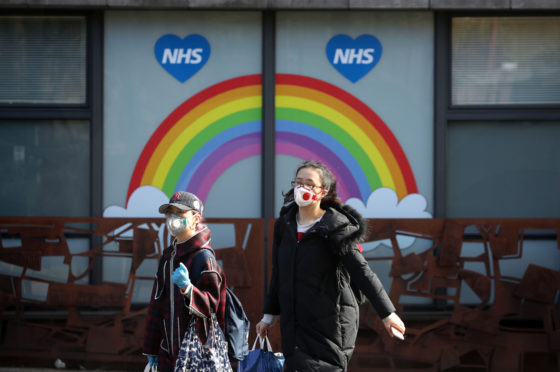
Intensive care doctors yesterday voiced new hope NHS Scotland is emerging from the worst of the Covid-19 crisis.
One doctor on the frontline described a dramatic change in his Intensive Care Unit over the last week as the number of critically-ill patients started to drop steadily.
He said the number of patients cared for in his ICU had halved and, after weeks of gruelling, traumatic shifts, staff were beginning to believe the worst may be over.
The doctor, who has been working throughout the coronavirus emergency, said: “There is something in the unit that feels a little like relief, a little like glimmers of light.”
However, specialists warned any relaxation in the lockdown risks a second wave of infection and more deaths.
Yesterday, it emerged more than 20,000 people in Britain have now died with Covid-19, a “terrible milestone”, according to ministers.
In Scotland, 1,231 patients have died in hospital after testing positive but the virus is mentioned on 1,616 death certificates.
In his weekly dispatch from one of Scotland’s Intensive Care Units, a doctor reveals the situation is improving but not, sadly, for many stricken patients.
What a difference a week makes. Our patient numbers have halved as our capacity drops back to 100%, having been regularly sitting at over 200% for weeks now.
Hospital admissions, referrals and ICU admissions with Covid-19 seem to be easing and there is something in the unit that feels a little like relief, a little like glimmers of light at the end of the darkest tunnel.
As the workload becomes more manageable, it brings with it slightly shorter stints in the visors, masks, gowns and gloves, regular breaks and, with every discharge, another faint whiff of optimism, the suspicion that we are making headway in this particular battle, although the war rages on.
Different parts of Britain are at different stages in their journey through these days of Covid but we seem to be past our peak and the staff here are talking about something that has not been discussed for weeks – resumption of some kind of normal life.
I can’t imagine our usual work patterns returning this year and patient flow may be altered forever. No doubt we will need green and red ICUs for the foreseeable future but we have started to discuss other patients, those without Covid.
The continued rise of excess deaths, many not directly attributed to Covid but almost certainly linked, is hugely worrying. The continued avoidance of hospitals and doctors by people is a clear danger to their health and may have a more devastating effect on our country than Covid itself. Last week urgent cancer referrals dropped 75%, for example.
We have consistently drilled into the public: stay home, protect the NHS and save lives. So as we seem to have endured the first wave of Covid, it’s clear we now need to think about relaxing some lockdown rules, perhaps softening the messages to ensure some of those who really need medical attention seek it.
Social distancing is here to stay for the foreseeable future but the implications on people’s physical and mental health if we cannot find a new normality will be huge, potentially catastrophic.
Despite the glints of optimism, our unit is still full of Covid patients, most with more than 14 daily ward rounds on their electronic notes. Some are getting better, some worse, some just treading water.
I’m sure the families of these patients will not share our feeling that things are improving, as they stare at their phone, willing it to ring, but dreading the news it might bring.
The families will fear the worst but, perhaps thankfully, can have no real appreciation of what their loved ones have endured, the scars both physical and mental that can be inflicted by an ICU stay, the muscle loss, the swelling from fluids, the psychological impact.
I phone one family, a family I have called many times before, somehow feeling I know them even though we have never met, and tell them there is nothing more we can do, no more hope to offer.
Breaking bad news with care, consideration and empathy is a skill needed by doctors, and I have learned it like we all have, but it has never been so difficult.
Delivering news like this over the phone is distressing on both sides of the connection. For us, there is no human contact, no visual cues, to help us deliver often terrible news. My words feel empty, without a visual, physical connection.
The sobs we have heard over a phone connection too often now are only ever broken to thank us for all we’ve done, how great the NHS has been. It is hard to take any comfort in that.
It is hard to hear, harder to bear, when someone thanks you after being told we can do no more.

Enjoy the convenience of having The Sunday Post delivered as a digital ePaper straight to your smartphone, tablet or computer.
Subscribe for only £5.49 a month and enjoy all the benefits of the printed paper as a digital replica.
Subscribe